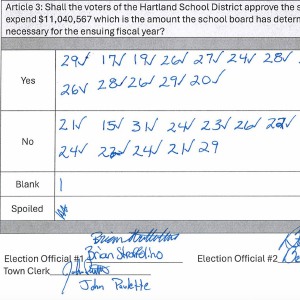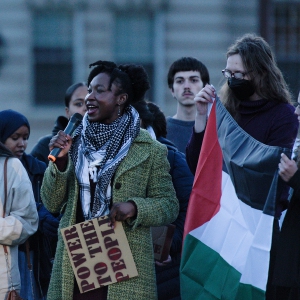Small, unpermitted huts offer a lifeline to homeless people but stir controversy in Hartford
| Published: 12-19-2020 9:54 PM |
WHITE RIVER JUNCTION — Bundled in snow pants and a thick knitted hat, Scott Alexander stepped over the wet leaves that lined the remote woods along the train tracks and moved through the trees before stopping in front of a small white hut.
“Sorry about the mess, we haven’t had time to clean,” Alexander said, before swinging open the door to the makeshift 6-by-10-foot home, smaller than two queen-size beds. Inside, a small wood bed frame carried a mattress, clothes spilled out of bags onto the floor below, and a small shelf held some supplies.
“We’ve foamed it and sealed it,” Alexander said “We’ve put time and effort into building it.”
He stood back and nodded toward the inside, explaining that the insulation from the walls, made of stark white polystyrene foam and sealed together with caulk, is enough to keep him and his wife warm during the increasingly cold months.
“Five minutes with the heat on and you don’t have to turn it on for the rest of the night,” he said.
Alexander is one of a small handful of homeless people in Hartford who have created and set up the structures, which can be detached from their wooden floors and are light enough to be carried by a few people. Three of them are set up in town, standing in a row tucked away at the base of a hill behind Worcester Avenue, down a long path through the woods.
But since the structures started going up in recent months, some residents — especially neighbors of the encampment — have raised concerns about safety hazards and legal concerns. Town officials say no one secured a permit to build them.
At a Selectboard meeting on Tuesday where the structures were discussed, Interim Town Manager John MacLean held a short presentation on the legal questions surrounding them. He said the huts are “not permitted” and do “not meet code.”
Article continues after...
Yesterday's Most Read Articles
 Hartland voters successfully petition for school budget revote
Hartland voters successfully petition for school budget revote
 JAG Productions announces closure, citing ‘crisis facing the arts’
JAG Productions announces closure, citing ‘crisis facing the arts’
 Hanover’s Perreard may soon capture the attention of collegiate coaches in two athletic pursuits
Hanover’s Perreard may soon capture the attention of collegiate coaches in two athletic pursuits
However, he added, “In these non-permitted structures, there’s clearly an attempt at a humanitarian response” to the homelessness crisis.
The huts’ construction and resulting controversy have underscored the difficulties of navigating regulations and bureaucracies while trying to provide meaningful emergency services to a growing homeless population, and the complexities of balancing policy with practicality.
It’s a challenge that Simon Dennis, who has been pushing the creation of the huts, has faced throughout his advocacy work with homeless people in Hartford. Dennis, who serves on the Selectboard, bought the supplies and materials to construct the dwellings, but has faced criticism in recent weeks from Hartford residents for his involvement.
Alexander; his wife, Lisa Laboy-Alexander; and friend Alex Becker recognize that the structures have drawn complaints from Hartford residents and even some town officials. But, Laboy-Alexander said, moving is not easy.
“It’s hard to uproot your life,” she said, explaining that the couple had moved from Barre earlier this year. “Why can’t we have a structure to get through the winters?”
Becker, who’s still living in a tent, shared Laboy-Alexander’s concerns. Stepping from foot to foot in the cold outside her small hut last week, he said he wishes he could have a dwelling of his own, especially as winter approaches.
“Everybody wants to judge us. ... We already feel bad. We’re stuck out here,” Becker said, addressing the complaints about the dwellings. “I just want to have a place to stay.”
When asked what his biggest fear is going into the winter, Becker answered without hesitation.
“Freezing to death,” he said. “In tents. In plastic.”
Dennis, an eight-year member of the Selectboard and head of the Center for Transformational Practice, has spent the past year working with homeless people and some advocates to address the growing problem of homelessness in Hartford. He said he was first inspired to look at the issue last winter, when several homeless people came in front of the board, describing dangerous living conditions amid a particularly brutal cold snap.
Dennis said the huts are meant to address some of the primary concerns for homeless people in the winter. The first is freezing to death. But when people sleep in closed areas with propane heaters, that can lead to two other dangers: carbon monoxide poisoning and fires.
Each hut is set on top of a wood pallet floor and has a wood bed frame, one window, a roof and some shelving. Dennis said the huts are heated with propane, and meters allow people to monitor the carbon monoxide in the air. Though he has helped obtain materials, Dennis said people in the community have made their own huts.
“These are emergency times. We are in the middle of a pandemic,” Dennis said, adding that several people in the homeless community have responded positively to the huts. “They are, quite frankly, a lifeline for people camping outside.”
On Wednesday, in the hours before a nor’easter walloped Hartford with nearly 2 feet of snow overnight into Thursday morning, Health Officer Brett Mayfield spoke to people staying in the encampment and urged them to find alternative shelter for the storm’s duration. While most of the people staying in the huts were able to find other temporary housing to wait out the storm, they expected to return to the huts.
While winter is always a particularly bad time for homeless people, the COVID-19 pandemic has exacerbated the challenges caused by dangerous weather. Following the coronavirus outbreak in the spring, many shelters were forced to reduce the number of people they could house, while others, like an annual cold weather shelter, closed completely.
Anticipating a housing issue at the beginning of the pandemic, Vermont gave vouchers to people who may need to stay in nearby hotels and motels. Town officials have said that brought more people enduring homelessness from around the state to the Hartford area, which has an abundance of hotels.
But in many cases, that didn’t work out. New tenants sometimes got into disagreements with each other, which in some cases led to evictions that forced people back out on the streets, Dennis said.
The result is a homeless population in Hartford on the rise, with many people running out of options as winter barrels into the region. Over the summer, then-Town Manager Brannon Godfrey said the total homeless population — including many who do not camp outside — was around 40 people before the pandemic. That number grew to around 100 in the months following the outbreak.
Precise numbers of people actually camping outside are difficult to track, but Dennis said he knows of about 20 living outside this year, compared with about 10 people on his radar last year.
“We have an unhoused population which is twice what it was,” Dennis said in an interview this month. “It’s a matter of life and death.”
Though Dennis and other advocates for the homeless community have pushed to keep the structures — at least until another viable option is found — many other town residents have voiced opposition to the dwellings.
A 2½-hour discussion during Tuesday’s Selectboard meeting ended with board members agreeing to form a group in hopes of quickly finding an alternative to the structures, but not before about 25 people spoke for or against them.
Some members of the public who spoke at the meeting, such as Sherry West, a White River Junction resident and assistant town clerk, said the town has already provided plenty of resources for homeless people, especially following a report put out by the town’s Committee on Homelessness earlier this year.
“Your homeless report already shows all the services,” she said, warning the town against becoming a “social service agency.”
Hartford resident Lannie Collins argued that the unpermitted dwellings could set a dangerous precedent for the town, and questioned what would happen if someone constructed other buildings — like a garage — without a permit.
“If this is ignored, what will be the next step that is overtaken?” he asked the board.
Resident Sue-Ellen Parmenter worried about a proposed $75,000 line item set aside for homeless assistance on the 2022 proposed budget, noting “sticker shock” and arguing that residents don’t know where that money would go. Later in the meeting, Dennis proposed cutting the number to $35,000, including a typical annual line item of $15,000 for homelessness issues, plus $20,000 that could be put toward a low-barrier shelter.
Other residents expressed support for structures — or at least, for helping members of the homeless community survive through the winter.
“We can debate the semantics of who has the authority and where the funding is going to come from” resident Lucas Gilbert said. “But all we’re really debating is whether or not we’re going to let people die from freezing to death this winter.”
Joseph Boots-Ebenfield argued that a garage or other permitted structure is very different from the dwellings. He also questioned why some residents were so concerned about the issue.
“How — and more importantly why — do you penalize people who have nothing to give?” he asked.
Anna Merriman can be reached at amerriman@vnews.com or 603-727-3216.

 At Dartmouth, hundreds protest ongoing war in Gaza and express support for academic freedom
At Dartmouth, hundreds protest ongoing war in Gaza and express support for academic freedom Over Easy: ‘A breakfast without a newspaper is a horse without a saddle’
Over Easy: ‘A breakfast without a newspaper is a horse without a saddle’
